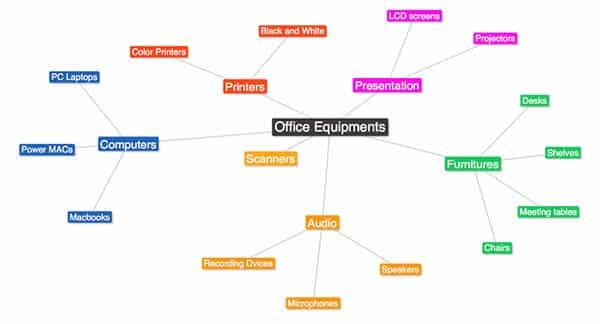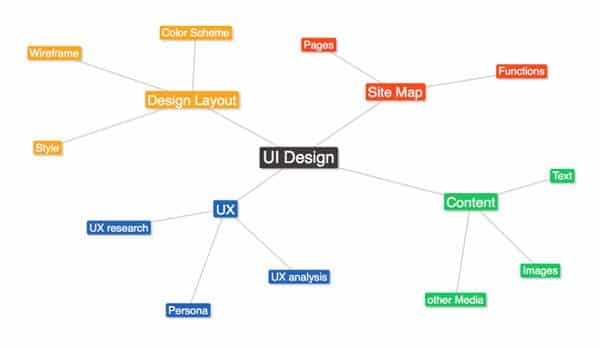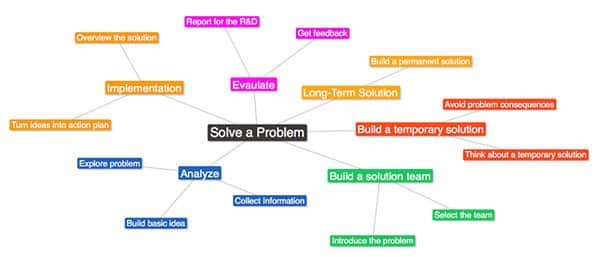Common Types of Mind Maps and How to Use Them
Mind maps are widely used by both designers and non-designers as a method for brainstorming in the early stages of projects in order to explore ideas or solve project problems. In a previous article, we explored the concept of mind maps and how to use them by starting with a core idea and expanding it in a tree diagram, to link ideas and elaborate these ideas into more details. Mind maps can be created using drawing on paper or a white board, using post-it sticky notes, or using online tools. Our Designorate Mind Map Template includes printing elements that can be used in building flexible mind maps.
As mind maps are widely used in team meetings, achieving a successful mind mapping session requires understanding the different types of mind maps and which one is appropriate fit during the meeting. Generally, there are three common types of mind maps based on the projects’ purpose: library mind maps are used to track information, presentation mind maps are used to present ideas, and tunnel timeline mind maps are used to organize and build a project plan. This taxonomy is related to the target of using mind maps and the type of information used in the brainstorming session.
Library Mind Maps
Library mind maps, also know as the reference maps, are used to organize information visually, so multiple pieces of information or topics can be scanned easily without losing any part. So, this mind map starts with a number of broken ideas or topics, and then, these ideas are organized together in a tree structure. This structure tends to build a linkage between related ideas and organize how the main topic intersects together. The library map focus on the idea, so it starts with the main idea and it directs the brainstorming session by following the related topics to the core ideas.

The library mind map can be used to achieve the following:
- Explore a specific topic and the related ideas around it. For example, team members may use this method to explore a specific problem, such as a traffic light, and all the topics related to this problem in order to solve it.
- Organize information about a specific project or topic in a visual method that can be easily tracked during the discussion.
Presentation Mind Maps
This type of mind map is used to present a progression of ideas, such as telling a story or tracking a call to action process. These mind maps tend to visually present the ideas’ flow in order to track the steps and the information related to each step. Unlike the reference mind map, the presentation mind map is designed to follow the discussion and visualize its specific flow, rather than controlling the session through the collected ideas. Therefore, this method focuses on the attendees rather than the topic. Although the main topic is written as the basis for the mind map, it is controlled with the team discussion.

This type of mind map can be used to achieve the following:
- Present a specific consumer behavior when using a product and the steps that the consumer followed in order to archive a specific goal, such as buying a product or subscribing to a website.
- Training sessions, when the trainee needs to follow a specific flow of information. It is a simplified version of a PowerPoint presentation with a more direct and straightforward approach.
- Discuss an argument or a situation and the steps based on this situation.
Planning Mind Maps
When planning for a specific project or choosing from different actions during the project progress, the planning mind map can be used to visually present various actions and the relations sub-actions the can be expected from different plans. For example, this type of mind map can be used for a specific plan, such as a project strategy, action plan, or problem solving. The core topic of the mind map reflects the desired outcome. Each sub-topic aims to represent a path that moves toward achieving the core target. For example, the core idea can be increasing the market share with specific percentage, and the related topic focuses on the plans to achieve this goal. These types of mind maps can be used to achieve the following:

- Plan projects and build project strategy that can be achieved through specific steps.
- Solve problems through setting the search for a solution as the main target and discussing the possible methods for solving the problem during the brainstorming session.
Conclusion
Mind map can be a powerful tool to explore creative ideas, build plans, or solve problems. However, many mind map sessions fail due to incorrect implementation for the method. In order to achieve a successful mind-mapping meeting, facilitators should implement the most appropriate mind map for achieving the meeting’s goal. The above three mind maps cover almost all the purposes where mind maps can be applied. Understanding the characteristics and the usage of each type is essential to achieving the desired outcome from mind map sessions.






